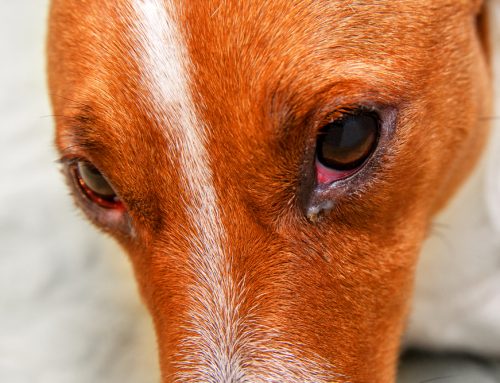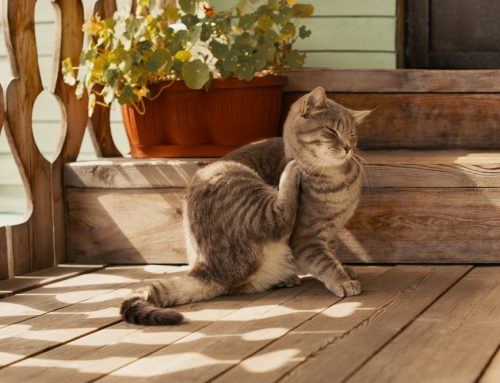If your pet becomes anxious or fearful during noisy events, such as thunderstorms or fireworks displays, they may be suffering from a condition known as noise aversion, a common yet often misunderstood issue in pets. Noise aversion affects approximately 67% of dogs and many cats in the United States, causing significant distress and a negative effect on their quality of life. While it’s normal for a pet to be startled by a loud or unfamiliar sound, the fear and anxiety a pet with noise aversion experiences are more extreme—similar to a panic attack experienced by a person—and the recovery time is much longer than that for most pets. Unfortunately, many pet owners consider their pet’s fear reaction to be a normal part of their behavior and don’t realize the condition can be managed. As a result, many pets continue to suffer untreated. Our team at Town & Country Animal Hospital created The Pet Owner’s Guide to Noise Aversion to spread awareness and help affected pets lead more comfortable and less stressful lives. Keep reading for an overview of everything you need to know about noise aversion in pets.
Understanding noise aversion in pets
Noise aversion is characterized by an exaggerated fear or phobia of select noises. Pets can become sensitized to any startling noise, and most noise-averse pets have several triggers, which may include:
- Fireworks
- Thunderstorms
- Car alarms
- Smoke detectors
- Construction noises
- Vacuums
- Hair dryers
While the causes are not fully understood, certain factors can influence the likelihood that a pet will develop noise aversion. Influencing factors may include:
- Breed — Any pet can be averse to noise, but certain dog breeds, such as herding dogs and working dogs (e.g., German shepherds), are especially prone to developing a sound sensitivity. In general, hunting dogs are bred to be unbothered by loud sounds, so they are typically less likely to react to noises such as gunfire.
- Inadequate socialization — A lack of socialization when a pet is young can lead to noise aversion. The best time to socialize a pet is during the first 12 to 16 weeks when their brains are still developing. During this sensitive socialization period, pets should be exposed to a variety of people, animals, and environments to help them grow into well-adjusted adults. Without proper socialization, pets often become fearful or anxious and have difficulty adjusting to new environments, people, and—you guessed it—sounds.

Recognizing the signs of noise aversion in pets
Identifying noise aversion in pets can be difficult, particularly in cats. Every pet reacts to anxiety and fear differently and may display a range of behavioral changes during or following exposure to a triggering sound. Watch your pet closely when loud sounds startle them. You may notice any combination of the following noise aversion signs:
- Heavy panting
- Excessive drooling
- Vocalization
- Hyper-alert attitude
- Pacing
- Trembling
- Clinging behavior
- Hiding
- Uncontrolled urination and defecation
- Digging, chewing, or attempting to escape
- Aggression
Noise aversion typically develops when a pet is 1 to 2 years old, and can progress and worsen without treatment. By working with your veterinarian, you can lower your pet’s stress and help them cope with loud noises.
Managing noise aversion in pets
Fortunately, there are ways to help pets cope with distressing sounds and improve their quality of life. Managing noise aversion involves a combination of the following strategies:
- Behavior modification — Techniques like desensitization and counter-conditioning can be used to help change a pet’s response to a particular stimulus.
- Desensitization — Desensitization involves gradually exposing your pet to a low level of the triggering noise and slowly increasing the volume over time as your pet becomes accustomed to the sound.
- Counter-conditioning — Counter-conditioning involves changing your pet’s emotional response to the noise, often by associating the noise with something positive like treats or play. Over time, your pet can learn to associate the noise with the positive experience, which can help reduce their fear and anxiety.
- Environmental management — At home, you can provide a quiet, secure area, such as a bedroom, crate, or closet where your pet can retreat during a triggering noise event. Include comfortable bedding, engaging toys, and soothing music for added comfort.
- Medication — Veterinarian-prescribed medication may be necessary to reduce your pet’s anxiety level and alleviate their mental suffering and distress. Calming supplements and medications can be given daily or only during noise events. Consult your veterinarian to determine the best medication and dose for your pet.
Noise aversion can be challenging for pets and their owners, but with understanding, patience and a multimodal treatment strategy, you can help your pet feel safe and secure. Fireworks and thunderstorms are common this time of year, so don’t wait to get help for your pet. If you notice noise aversion signs in your pet, contact our Town & Country Animal Hospital team so we can create an individualized treatment plan for them.







Leave A Comment